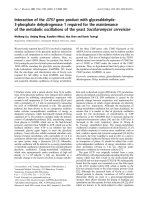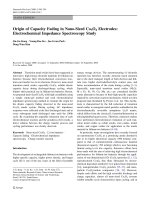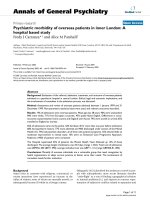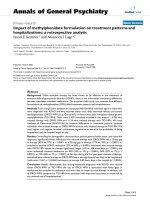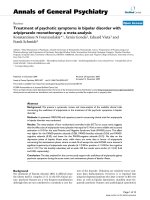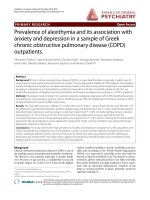Báo cáo y học: "Chronicity of sleep problems in children with chronic illness: a longitudinal population-based study" pdf
Bạn đang xem bản rút gọn của tài liệu. Xem và tải ngay bản đầy đủ của tài liệu tại đây (238.85 KB, 7 trang )
BioMed Central
Page 1 of 7
(page number not for citation purposes)
Child and Adolescent Psychiatry and
Mental Health
Open Access
Research
Chronicity of sleep problems in children with chronic illness: a
longitudinal population-based study
Børge Sivertsen*
1
, Mari Hysing
2
, Irene Elgen
3
, Kjell Morten Stormark
4
and
Astri J Lundervold
2,4
Address:
1
Department of Clinical Psychology, University of Bergen, Bergen, Norway,
2
Department of Biological and Medical Psychology,
University of Bergen, Norway,
3
Department of Pediatrics, Haukeland University Hospital, Bergen, Norway and
4
Centre for Child and Adolescent
Mental Health, Unifob Health, Bergen, Norway
Email: Børge Sivertsen* - ; Mari Hysing - ; Irene Elgen - ;
Kjell Morten Stormark - ; Astri J Lundervold -
* Corresponding author
Abstract
Background: The aim of this study was to examine the chronicity of sleep problems in children
with chronic illness, and potential predictors of sleep problems.
Methods: Using data from a longitudinal total population study in Norway, The Bergen Child
Study, data on sleep problems, chronic illness and potential confounders were assessed at ages 79
and 1113.
Results: 295 of 4025 (7.3%) children had a chronic illness, and the prevalence of chronic sleep
problems was significantly higher in this group compared to children without chronic illness (6.8%
versus 3.6%). Sleep problems at the first wave increased the risk of sleep problems at the second
wave, also when adjusting for potential confounders (odds-ratio = 5.41). Hyperactivity and
emotional problems were also independent risk factors for later sleep problems.
Conclusion: These findings call for increased awareness and development of treatment strategies
of sleep problems in children with chronic illness.
Background
Sleep problems are among the most common complaints
in children, and have been linked to a range of negative
consequences, including reduced daytime functioning,
academic and cognitive deficits as well as increased risk of
emotional and behavioural problems [1,2]. Children with
chronic illness are at increased risk for sleep problems,
and several cross-sectional studies have found an
increased rate of sleep problems in children with specific
chronic illnesses, including cerebral palsy [3], epilepsy
[4], asthma [5], headaches [6], and migraine [7]. In one of
the few population-based studies assessing sleep prob-
lems among children with chronic illness, Hysing et al. [8]
found that these children reported more problems falling
asleep and had more night-time awakenings compared to
their healthy peers.
Few longitudinal studies of children in the general popu-
lation have explored the stability of sleep problems, and
with mixed findings. In a Swiss study [9] following chil-
dren from infancy to 10 years, night-time awakenings
were found to be both frequent and persistent over time.
Published: 27 August 2009
Child and Adolescent Psychiatry and Mental Health 2009, 3:22 doi:10.1186/1753-2000-3-22
Received: 18 June 2009
Accepted: 27 August 2009
This article is available from: />© 2009 Sivertsen et al; licensee BioMed Central Ltd.
This is an Open Access article distributed under the terms of the Creative Commons Attribution License ( />),
which permits unrestricted use, distribution, and reproduction in any medium, provided the original work is properly cited.
Child and Adolescent Psychiatry and Mental Health 2009, 3:22 />Page 2 of 7
(page number not for citation purposes)
In contrast, Gregory et al. [10] found a reduction of sleep
problems from early childhood to mid-adolescence, and
Laberge et al. [11] found a similar reduction in sleep onset
problems in children from 10 to 13 years. However, little
is known with regards to the chronicity of sleep problems
in children with chronic illness, and to the best of our
knowledge, no longitudinal population-based studies
have investigated the stability of sleep problems over time
in this group of children.
The increased rate of sleep problems in children with
chronic illness may have several potential pathways, some
of them suggesting a higher likelihood of chronicity. For
example, chronic illness may affect the sleep physiology
and sleep systems in disorders with impaired central nerv-
ous system (CNS) functioning. Other factors contributing
to a chronic trajectory of sleep problems in chronic illness
may include higher rates of upper-airway obstruction and
BMI (body mass index), as well as emotional and behav-
ioural disorders, which previously has been linked to
sleep problems in children with chronic illness [8]. It is
also possible that parental stress related to managing their
child's chronic illness might contribute to poor imple-
mentation of sleep schedules, and thus sleep problems.
Based on the same study population as the study by Hys-
ing et al. [8], the current paper linked two waves of the
Bergen Child Study (BCS), assessing all children at two
time points (79 and 1113 years of age) in order to explore
the chronicity of sleep problems in children with chronic
illness. We hypothesized that children with chronic illness
would report higher rates of both acute and chronic sleep
problems than their peers, and that sleep problems would
differ between specific subgroups of chronic illnesses. We
expected both sleep problems and behavioural and emo-
tional problems to predict subsequent sleep problems.
Methods
Study design and subjects
Data stem from the first and second wave of the BCS, car-
ried out in the fall 2002 and spring 2006, respectively. The
BCS is a longitudinal total population-based study of chil-
dren in all public and private schools in the city of Bergen,
Norway. The protocol and population of the BCS is
described in detail elsewhere [8,12]. In short, in the first
wave, the target population was 9430 primary school chil-
dren aged 7 to 9 years, of which 7007 parents gave their
informed consent to participate, yielding a response rate
of 74.3%. The second wave was conducted in 2006, and in
all 5196 children, now aged 11 to 13 years, participated
(response rate: 55.1%). A total of 4025 children partici-
pated in both waves. In all, 387 children were reported by
their parents to have a chronic illness in the second wave.
The 295 (7.3%) children who were identified to have such
an illness in both waves were included in the present
study.
Instruments
Chronic illness (wave 2 only)
Chronic illness (CI) was defined the following way: All
parents responded to a simple question in wave 2 of the
BCS regarding whether or not their child had a chronic ill-
ness or a disability. Parents who rated such illness/disabil-
ity as present went on to categorize it as either (1) asthma,
(2) epilepsy, (3) diabetes, (4) mental retardation or (5)
other illnesses. Parents who endorsed other illness were
asked to specify in their own words what that illness was.
Of the 5683 children, 387 (9.6%) were reported to have
at least one CI. An experienced paediatrician (IE) catego-
rized the illness in subgroups. In the present study three
subgroups of chronic illness were identified and included;
somatic illness, neurological illness and asthma. Due to
the overlap between children with asthma and allergy/
eczema, the children where the parents only reported
allergy/eczema were excluded. Thus, CI was defined as
reported by parents and only somatic disorders were
included (see Table 1 for all included illnesses). Children
reported to have psychiatric disorders (n = 25) and spe-
cific learning disabilities (n = 6) on the question about
physical illness were included in the non-chronically ill
group for statistical analyses. Children with more than
one chronic illness were categorized to one illness group
in the following order: neurological disorders, asthma
and somatic illness. Note that children may have more
than one diagnosis.
Emotional and behavioural disorder (wave 1 and 2)
The Strengths and Difficulties Questionnaire (SDQ)
[13,14] is a behavioural screening questionnaire for chil-
dren aged 416 years comprising 25 items, which can be
allocated to five subscales with five items each: (1) emo-
tional symptoms, (2) conduct problems, (3) hyperactiv-
ity-inattention problems, (4) peer relationship problems
and (5) pro-social behaviour. A total difficulty score is
computed by combining the first four subscale scores.
Each subscale is scored on a three-point scale; 'not true',
'somewhat true', and 'certainly true', with total subscale
scores each ranging from 010, and total difficulties score
from 040. The SDQ has been extensively validated in var-
ious countries (e.g. in population studies of children and
adolescents in Nordic countries) [15-17]. The SDQ was
completed by the parents in wave 1, whereas in wave 2 the
SDQ was provided also by the children.
Sleep problems (wave 1 and 2)
Child-reported sleep problems were assessed with one
question encompassing difficulties with initiating and/or
maintaining sleep (DIMS: "Does your child have prob-
lems initiating sleep or have frequent awakenings"), rated
on a three-point Likert scale ("completely correct" "partly
correct" and "not correct"). A dichotomous variable was
used for the purposes of the present study, in which
responding either "completely correct" or "partly correct"
Child and Adolescent Psychiatry and Mental Health 2009, 3:22 />Page 3 of 7
(page number not for citation purposes)
was defined as having DIMS. No data on the time-frame
or severity of the sleep problems were available. This oper-
ationalization has previously been applied in the BCS
[18]. Chronic sleep problems were defined as reporting
DIMS at both waves, whereas transient (acute) sleep prob-
lems were defined as reporting DIMS at either of the two
waves.
Demographical/clinical information (wave 2 only)
Level of the parental education was reported in three cat-
egories (primary school, secondary school and college/
university), while household economy was rated as good,
medium or poor by the parents. The child's body mass
index (BMI) was calculated as weight (kg) divided by
squared height (cm). For the purposes of the present study
we used the following percentiles: "underweight": Less
than the 5th percentile, "healthy weight": 5th percentile to
less than the 85th percentile, "overweight": 85th to less
than the 95th percentile, and "obese": Equal to or greater
than the 95th percentile [19].
Statistics
Pearson Chi-Square Tests and Kruskal-Wallis analysis of
variance (ANOVA) with multiple comparisons were used
to examine differences on demographics, clinical charac-
teristics and sleep variables, in children with and without
chronic illness. Wilcoxon Signed Ranks Test was used to
examine differences in the prevalence of sleep problems
in the whole sample. Non-parametrical tests were chosen
due to the non-normality of the data. Logistic regression
analyses were used to further explore the association
between chronic illness and sleep problems. In general,
logistic regression analysis is considered a robust and
appropriate analysis also in non-normal data. Both unad-
justed (crude) analyses, as well as separate analyses adjust-
ing for A) gender and age, B) income, education and BMI,
C) parent-reported behavioural problems, and D) child-
reported behavioural problems were conducted. The
rationale for including behavioural problems at both
waves in the regression model was to investigate the effect
of both previous and co-existing behavioural problems on
sleep problems. A fully adjusted analysis including all the
listed potential confounders was also conducted. Finally,
logistic regression analyses were conducted with the SDQ-
factors as the exposure variable on subsequent sleep prob-
lems. Results are presented as odds ratios (OR) with 95
percent confidence intervals. Analyses were performed
using SPSS for Windows 17, and the alpha level was set at
a two-tailed 5%.
Ethics
The study was approved by the National Data Inspectorate
and the Regional Committee for Medical and Health
Research Ethics in western Norway. Written informed
consent was obtained from all parents included in this
study. Participants received no payment to participate.
Results
Sample characteristics
There were significantly more boys than girls in the
chronic illness group, a larger proportion was overweight/
obese, and they were more likely to have a lower family
income (Table 2). Children with chronic illness also
reported significantly higher levels of emotional and
behavioural problems at both waves compared to the no
chronic illness group. No significant differences were
found on age or parental education between the two
groups.
Chronicity of sleep problems
Overall, sleep problems increased significantly during the
4 year-period (8.1% to 12.3%, Z = 7.35, p < .001), with an
Table 1: Sub-groups of chronic illness in the second wave of the Bergen Child Study*
Subgroups (n) n
Neurological disorders (76) Mental retardation and related syndromes 27
Epilepsy 20
Migraine 13
Cerebral palsy 6
Hydrocephalus and myelomeningocele 4
Other 6
Asthma (188)
Somatic disorders (55) Diabetes 14
Gastrointestinal disorders 14
Skeletal disorders 12
Cardiovascular disorders 3
Heamophiliac 3
Kidney 3
Endocrinological disorders 3
Muscle disorders 2
Rheumatism 1
* Children may have more than one chronic illness
Child and Adolescent Psychiatry and Mental Health 2009, 3:22 />Page 4 of 7
(page number not for citation purposes)
increase from 15.3% to 18.8% in the chronic illness group
and from 7.6 to 11.8% in the non-chronically ill group.
The prevalence of chronic sleep problems (DIMS at both
waves) was significantly higher among children with
chronic illness (6.8%) compared to children with no
chronic illness (3.6%) (χ
2
= 23.54, df = 3, p < .001,
Figure 1).
Sleep problems reported only at wave 1 was also signifi-
cantly higher in the chronic illness group compared to
their healthy peers (7.5% vs. 3.6%, OR = 2.52, 95%: CI
1.584.01), as also was the case for sleep problems only at
wave 2 (10.5% vs. 7.7%, OR = 1.67, 95%: CI 1.142.47).
Among the children with chronic illness, children with
neurological disorders were more likely to have chronic
sleep problems compared to children with either asthma
or somatic disorders (χ
2
= 55.60, df = 6, p < .001, Figure 2).
There were no differences in remission rates between chil-
dren with and without chronic illness (38.2% vs. 46.3%,
(χ
2
= 1.06, df = 2, p = .59).
Predictors of sleep problems
Logistic regression analyses showed that children with a
chronic illness reporting sleep problems in wave 1 had a
six-fold increased risk of also having sleep problems at
wave 2 (OR= 6.04, 95% CI: 2.9612.33). Adjusting for
Table 2: Demographic and clinical characteristics in children with and without chronic illness at wave 2.
Characteristics No chronic illness Chronic illness P-value
N 3730 295
Girls, % (n) 53.3 (1988) 42.7 (126) < 0.001
Wave 1
Age* 8.27 (8.248.30) 8.23 (8.138.33) .47
Emotional and behavioural problems (SDQ Parents-reported)*
Emotion 1.16 (1.111.21) 1.89 (1.652.13) <.001
Conduct 0.82 (0.780.86) 1.16 (0.991.33) <.001
Hyperactivity 2.40(2.332.46) 3.27 (2.983.57) <.001
Peer 1.16 (1.111.21) 1.89 (1.652.13) <.001
Total 5.16 (5.025.30) 7.77 (7.038.50) <.001
Wave 2
Body-mass index, % (n)
Boys <.001
Underweight 4.5% (82) 3.2% (6)
Healthy weight 81.0% (1486) 73.8% (138)
Overweight 9.5% (175) 10.7% (20)
Obese 5.0% (91) 12.3% (23)
Girls .008
Underweight 6.2% (133) 4.2% (6)
Healthy weight 80.6% (1730) 72.7% (104)
Overweight 9.1% (196) 14.7% (21)
Obese 4.1% (88) 8.4% (12)
Economy, n (%) .013
Good 68.4 (3124) 64.2 (239)
Medium 29.0 (1326) 30.6 (114)
Poor 2.6 (120) 5.1 (19)
Education mother, n (%) .31
Primary 8.3 (368) 10.7 (37)
Secondary 39.5 (1746) 38.8 (134)
College/University 52.1 (2303) 50.4 (174)
Education father, n (%) .74
Primary 8.2 (374) 8.1 (30)
Secondary 37.7 (1712) 39.7 (147)
College/University 54.0 (2452) 52.2 (193)
Emotional and behavioural problems (SDQ Child-reported)*
Emotion 1.61 (1.561.66) 2.16 (1.952.38) <.001
Conduct 1.05 (1.021.09) 1.22 (1.081.36) .028
Hyperactivity 2.52 (2.462.57) 3.08 (2.863.31) <.001
Peer 1.09 (1.051.14) 1.70 (1.501.90) <.001
Total 6.27 (6.146.41) 8.17 (7.598.76) <.001
* Data presented as mean (95% CI)
Child and Adolescent Psychiatry and Mental Health 2009, 3:22 />Page 5 of 7
(page number not for citation purposes)
potential confounders, including demographics, BMI,
and emotional and behavioural problems, reduced the
effect to OR = 5.41 (95% CI: 1.5918.40, Table 3).
To further explore the independent effect of emotional
and behavioural problems, separate analyses were con-
ducted with the SDQ as the exposure variable. As detailed
in Table 4, both hyperactivity and emotional problems at
wave 1 significantly predicted sleep problems in wave 2 in
the unadjusted analyses. These effects remained signifi-
cant when adjusting for sleep problems in wave 1 (hyper-
activity problems: OR= 1.38, 95% CI: 1.131.69, and
emotional problems: OR= 1.28, 95% CI: 1.081.51). Con-
duct problems and peer relationship problems were unre-
lated to subsequent sleep problems.
Discussion
The aim of the current study was to examine the chronicity
and predictors of sleep problems in children with chronic
illness compared to their healthy peers. Overall, the prev-
alence of sleep problems in both children with and with-
out chronic illness increased from wave 1 to 2. Children
with chronic illness had a higher rate of both chronic and
acute sleep problems. Sleep problems at wave 1 was the
strongest predictor of subsequent sleep problems. In addi-
tion, hyperactivity and emotional problems were smaller
but significant risk factors.
While prospective studies of sleep problems in children in
general have yielded mixed results on chronicity [9-11],
the current study indicates that children have more prob-
lems initiating and maintaining sleep as they enter early
adolescence, both in the chronic illness and non-chronic
illness group. Being the first study to explore the course of
sleep problems in children with chronic illness, the cur-
rent findings show that both persistent and transient sleep
problems are significantly more common in children with
a chronic illness compared to healthy children. As such,
the current study extends on previous cross-sectional evi-
dence of sleep problems being more common in children
with chronic illness [18].
There are several potential factors that may explain the
increased persistency of sleep problems in the chronic ill-
ness group. Having a neurological disorder greatly
increased the risk of developing chronic sleep problems.
General risk factors, such as sociodemograhic factors and
BMI, were found to be more prevalent in the chronic ill-
ness group, but only slightly reduced the risk of sleep
problems at wave 2, and could hence not account for the
high rate of sleep problems in the group as a whole. [20].
Table 3: Sleep problems in wave 1 as a predictor of sleep problems in wave 2, adjusting for potential confounders
Odds-ratio 95% CI
Unadjusted (Sleep problems in Wave 1) 6.04 2.9612.33
A Gender, age 6.35 3.0513.20
B Income, education, and BMI (Wave 2) 6.10 2.6214.21
C Parent -reported behavioural problems (Wave 1) 4.57 2.0410.23
D Child-reported behavioural problems (Wave 2) 4.77 2.0111.36
Fully adjusted model* 5.41 1.5918.40
* Adjusting for all the confounders listed above (A+B+C+D).
Chronicity of sleep problems in children with and without chronic illnessFigure 1
Chronicity of sleep problems in children with and
without chronic illness. DIMS = difficulties initiating and/
or maintaining sleep.
0 %
2 %
4 %
6 %
8 %
10 %
12 %
Wave 1 only Wave 2 only Both waves
DIMS
Prevalence
No chronic illness
Chronic illness
Sleep problems at wave 1 and/or 2 in subgroups of chronic illnessFigure 2
Sleep problems at wave 1 and/or 2 in subgroups of
chronic illness. DIMS = difficulties initiating and/or main-
taining sleep.
0 %
2 %
4 %
6 %
8 %
10 %
12 %
14 %
16 %
18 %
DIMS first only DIMS second only DIMS both
Asthma
Somatic
Neurological
Child and Adolescent Psychiatry and Mental Health 2009, 3:22 />Page 6 of 7
(page number not for citation purposes)
In a previous report from the same study [18], behav-
ioural and emotional problems were found to account for
most of the sleep problems in children with chronic ill-
ness. However, due to the cross-sectional nature of that
study, no conclusions could be drawn about directions of
causality. In the current study, we show that emotional
and behavioural problems are independent risk factors for
later sleep problems. As emotional problems was one of
the strongest predictors of later sleep problems one poten-
tial mechanism of this association may be through
increased worry at bedtime, which may delay sleep onset
and increase night-time awakenings in the child. In sum,
these findings emphasize the need for early detection of
emotional and behavioural problems in this population.
There are several limitations to the present study. Chronic
illness was assessed by parent report only, without medi-
cal verification of the diagnosis. Difficulties initiating or
maintaining sleep were assessed by a joint variable, mak-
ing it difficult to examine each construct separately and to
assess the importance of the finings, and we also had no
measure of the severity and duration of the sleep prob-
lems. Although not a validated measurement of sleep
problems, we still consider that its inclusion in the present
study design adds valuable information in a field and age
cohort in which the focus on sleep problems has been vir-
tually non-existing in epidemiological research. Unfortu-
nately, the operationalization of insomnia and sleep
problems has been extremely diverse in the general sleep
literature, causing problems when comparing results
across studies [21,22]. Therefore, future studies should
seek to employ validated instruments based on agree-
upon diagnostic criteria when assessing sleep problems to
facilitate study comparisons. Also, we had no measure of
symptoms of obstructive sleep apnoea (OSA), which pre-
viously has been linked to obesity in children in general.
OSA may be one potential mechanism through which
obesity may contribute to increased sleep problems in this
group. Another limitation is number of dropouts from
wave 1 to 2, and we unfortunately have no information as
to why these families did not participate in the longitudi-
nal study. Also, several of the potential factors that could
affect the relationship between sleep and chronic illness
were only assessed in the second wave, and hence could
not be used as predictors of chronicity of sleep problems.
Finally, children with mental retardation were included in
chronic illness group, the reason being the high degree of
overlap between parent-reported mental retardation and
having another neurological disorder. As such, excluding
mental retardation from the CI-group would both have
considerably reduced the sample size as well placed a sub-
stantial amount of children with CI in the healthy com-
parison group.
Increased awareness of the course of sleep problems over
time is important for both clinicians, as well as to caregiv-
ers. In contrast to the common belief that children often
will outgrow their sleep problems, the current study
shows that this may not be the case, especially in children
with chronic illness, thereby emphasizing the need to
develop treatment strategies for this group of children. In
addition, previous studies in the adult population have
shown that even small improvements in sleep quality may
yield noticeable relief in other co-existing symptoms
(such as pain or fatigue) [23]. There is now substantial evi-
dence that behavioural interventions are efficacious in
treating sleep problems in children [24], with more than
80% showing clinically significant and lasting improve-
ments. In addition, pharmacological interventions may
be beneficial in subgroups of children with CI. In cases
where mental retardation and hyperactivity co-exist with
other chronic illnesses, circadian rhythm sleep disorders
plays an important role in the aetiology of the sleep prob-
lems, in which adequately timed melatonin has shown to
effectively relieve chronic sleep problems [25-28]. When
also considering that improved sleep may have positive
effects on both psychological, academic and possibly
physiological variables [29], we consider it especially
important that sleep problems in children with chronic
illness are detected and managed adequately. Because dis-
rupted sleep in children also influences other members of
the family and remains a primary concern for many par-
ents and caregivers [30], the quality of life for the child as
well as her or his family as a whole may improve follow-
ing treatment of sleep problems.
Competing interests
The authors declare that they have no competing interests.
Table 4: Behavioural and emotional problems (parent-reported in wave 1) as predictors of sleep problems in wave 2.
Unadjusted Adjusting for sleep problems (wave 1)
Odds-ratio 95% CI Odds-ratio 95% CI
Emotional problems 1.33 1.131.55 1.28 1.081.51
Conduct problems 1.16 0.901.51 1.04 0.791,37
Hyperactivity problems 1.30 1.081.56 1.38 1.131.69
Peer problems 1.02 0.841.22 1.03 0.851,24
Publish with BioMed Central and every
scientist can read your work free of charge
"BioMed Central will be the most significant development for
disseminating the results of biomedical research in our lifetime."
Sir Paul Nurse, Cancer Research UK
Your research papers will be:
available free of charge to the entire biomedical community
peer reviewed and published immediately upon acceptance
cited in PubMed and archived on PubMed Central
yours — you keep the copyright
Submit your manuscript here:
/>BioMedcentral
Child and Adolescent Psychiatry and Mental Health 2009, 3:22 />Page 7 of 7
(page number not for citation purposes)
Authors' contributions
BS and MH carried out the statistical analyses and drafted
the manuscript. AJL and KMS participated in the design of
the study, and AJL provided critical comments in drafting
the manuscript. IE provided categorization of chronic ill-
ness conditions, and aided in the drafting process. All
authors read and approved the final manuscript.
Acknowledgements
The Centre of Child and Adolescent Mental Health, Unifob Health, Bergen,
is responsible for the Bergen Child study, funded by the University of Ber-
gen, the Norwegian Directorate for Health and Social Affairs, and the
Western Norway Regional Health Authority. We are grateful to the chil-
dren, parents and teachers participating in the BCS, and to the other mem-
bers of the project group for making the study possible.
References
1. Chorney DB, Detweiler MF, Morris TL, Kuhn BR: The interplay of
sleep disturbance, anxiety, and depression in children. J Pedi-
atr Psychol 2008, 33(4):339-348.
2. Curcio G, Ferrara M, De Gennaro L: Sleep loss, learning capacity
and academic performance. Sleep Med Rev 2006, 10(5):323-337.
3. Newman CJ, O'Regan M, Hensey O: Sleep disorders in children
with cerebral palsy. Dev Med Child Neurol 2006, 48(7):564-568.
4. Becker DA, Fennell EB, Carney PR: Daytime behavior and sleep
disturbance in childhood epilepsy. Epilepsy Behav 2004,
5(5):708-715.
5. Sadeh A, Horowitz I, Wolach-Benodis L, Wolach B: Sleep and pul-
monary function in children with well-controlled, stable
asthma. Sleep 1998, 21(4):379-384.
6. Bursztein C, Steinberg T, Sadeh A: Sleep, sleepiness, and behav-
ior problems in children with headache. J Child Neurol 2006,
21(12):1012-1019.
7. Heng K, Wirrell E: Sleep disturbance in children with migraine.
J Child Neurol 2006, 21(9):761-766.
8. Hysing M, Sivertsen B, Stormark KM, Elgen I, Lundervold AJ: Sleep in
children with chronic illness, and the relation to emotional
and behavioral problems a population-based study. J Pediatr
Psychol 2009, 34(6):665-670.
9. Jenni OG, Fuhrer HZ, Iglowstein I, Molinari L, Largo RH: A longitu-
dinal study of bed sharing and sleep problems among Swiss
children in the first 10 years of life. Pediatrics 2005, 115:233-240.
10. Gregory AM, O'Connor TG: Sleep problems in childhood: a lon-
gitudinal study of developmental change and association
with behavioral problems. J Am Acad Child Adolesc Psychiatry 2002,
41(8):964-971.
11. Laberge L, Petit D, Simard C, Vitaro F, Tremblay RE, Montplaisir J:
Development of sleep patterns in early adolescence. J Sleep
Res 2001, 10(1):59-67.
12. Hysing M, Elgen I, Gillberg C, Lie SA, Lundervold AJ: Chronic phys-
ical illness and mental health in children. Results from a
large-scale population study. J Child Psychol Psychiatry 2007,
48(8):785-792.
13. Goodman R: The extended version of the Strengths and Diffi-
culties Questionnaire as a guide to child psychiatric caseness
and consequent burden. J Child Psychol Psychiatry 1999,
40(5):791-799.
14. Goodman R: Psychometric properties of the strengths and dif-
ficulties questionnaire. J Am Acad Child Adolesc Psychiatry 2001,
40(11):1337-1345.
15. Heiervang E, Stormark KM, Lundervold AJ, Heimann M, Goodman R,
Posserud MB, Ullebo AK, Plessen KJ, Bjelland I, Lie SA, Gillberg C:
Psychiatric disorders in Norwegian 8- to 10-year-olds: an epi-
demiological survey of prevalence, risk factors, and service
use. J Am Acad Child Adolesc Psychiatry 2007, 46(4):438-447.
16. Muris P, Meesters C, Berg F van den: The Strengths and Difficul-
ties Questionnaire (SDQ) further evidence for its reliability
and validity in a community sample of Dutch children and
adolescents. Eur Child Adolesc Psychiatry 2003, 12(1):1-8.
17. Smedje H, Broman JE, Hetta J, von Knorring AL: Psychometric
properties of a Swedish version of the "Strengths and Diffi-
culties Questionnaire". Eur Child Adolesc Psychiatry 1999,
8(2):63-70.
18. Hysing M, Sivertsen B, Stormark KM, Elgen I, Lundervold AJ: Sleep in
Children with Chronic Illness, and the Relation to Emotional
and Behavioral Problems A Population-Based Study. J Pediatr
Psychol 2009, 34(6):665-70. Epub 2008 Sep 11.
19. Center for Disease Control and Prevention: Healthy Weight:
Assessing Your Weight: BMI: About BMI for Children and
Teens. 2009 [ />childrens_BMI/about_childrens_BMI.html].
20. Tauman R, Gozal D: Obesity and obstructive sleep apnea in
children. Paediatr Respir Rev 2006, 7(4):247-259.
21. Edinger JD, Bonnet MH, Bootzin RR, Doghramji K, Dorsey CM, Espie
CA, Jamieson AO, McCall WV, Morin CM, Stepanski EJ: Derivation
of research diagnostic criteria for insomnia: report of an
American Academy of Sleep Medicine Work Group. Sleep
2004, 27(8):1567-1596.
22. Lichstein KL, Durrence HH, Taylor DJ, Bush AJ, Riedel BW: Quanti-
tative criteria for insomnia. Behav Res Ther 2003, 41(4):427-445.
23. Stepanski EJ, Rybarczyk B: Emerging research on the treatment
and etiology of secondary or comorbid insomnia. Sleep Med
Rev 2006, 10(1):7-18.
24. Mindell JA, Kuhn B, Lewin DS, Meltzer LJ, Sadeh A: Behavioral
treatment of bedtime problems and night wakings in infants
and young children. Sleep 2006, 29(10):1263-1276.
25. Hoebert M, Heijden KB van der, van Geijlswijk IM, Smits MG: Long-
term follow-up of melatonin treatment in children with
ADHD and chronic sleep onset insomnia. J Pineal Res 2009,
47(1):1-7.
26. Braam W, Didden R, Smits M, Curfs L: Melatonin treatment in
individuals with intellectual disability and chronic insomnia:
a randomized placebo-controlled study. J Intellect Disabil Res
2008, 52(Pt 3):256-264.
27. Braam W, Smits MG, Didden R, Korzilius H, Van Geijlswijk IM, Curfs
LM: Exogenous melatonin for sleep problems in individuals
with intellectual disability: a meta-analysis. Dev Med Child Neu-
rol 2009, 51(5):340-349.
28. Heijden KB Van der, Smits MG, Van Someren EJ, Ridderinkhof KR,
Gunning WB: Effect of melatonin on sleep, behavior, and cog-
nition in ADHD and chronic sleep-onset insomnia. J Am Acad
Child Adolesc Psychiatry 2007, 46(2):233-241.
29. Wolfson AR, Carskadon MA: Sleep schedules and daytime func-
tioning in adolescents. Child Dev 1998, 69(4):
875-887.
30. Meltzer LJ, Moore M: Sleep disruptions in parents of children
and adolescents with chronic illnesses: prevalence, causes,
and consequences. J Pediatr Psychol 2008, 33(3):279-291.



